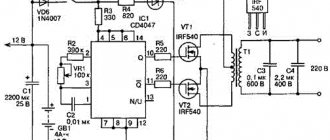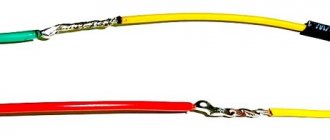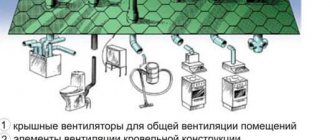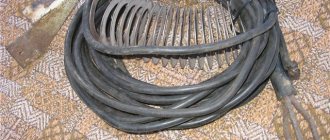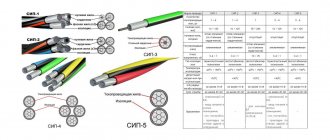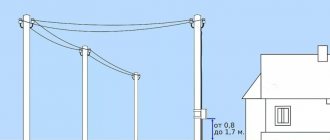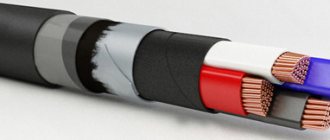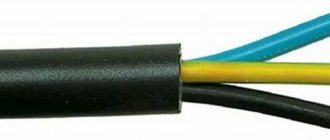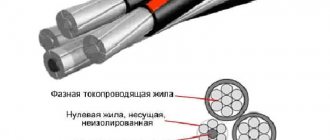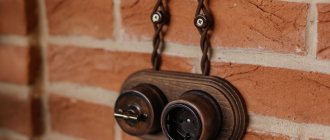Cable trays are electrical products used in electrical installation work to create channels for cable routes without grooves.
They are also called cable support systems.
They are used to accommodate not only cables, but also wires of various types, video surveillance systems - the trays allow you to mount a large number of systems - security, engineering, etc. because they can be mounted in unused spaces.
But in most cases they are used in industrial facilities, office premises, warehouses, and large stores.
Cable trays are indispensable parts of any infrastructure.
Why do you need to lay cables in trays?
Installation of cable trays is a mandatory component of the installation of protected electrical routes, regardless of their functional purpose. The advantages of placing cables and wires in special protective structures are listed below:
- mounted chains are reliably protected from mechanical damage;
- the service life of cable and wire routes is extended;
- in this case, it is possible to lay the power cable separately in a tray separated from the control (low-current) circuits by a special partition;
- simplifies access to cable products if they need to be repaired.
important:
Laying cables and wires in trays and boxes reduces the likelihood of their destruction in a fire.
In addition, they are partially protected from short circuits in the event of an emergency ingress of moisture into the internal spaces.
The disadvantages of laying cables in a tray include:
- Significant material consumption (compared to open wiring).
- Labor costs are increasing.
- There is no air circulation and dust accumulates (this only applies to products without perforation).
It is easier to prove the feasibility of using trays if you become familiar with the existing types of these structures and their functionality.
Attaching the tray to the floor
These schemes are variations of the already discussed methods of laying a cable route along a ceiling or wall. Thus, in the first two schemes, the ceiling mount was replaced with a floor mount, and the universal bracket-bracket is just as easily mounted on the floor as on the wall.
Click on the picture to go to the corresponding diagram
| Fastening to the floor using a bracket and stand | Installing a tray using a mounting profile and stand | Using the Floor Mounting Bracket |
Types of cable trays
Known types of cable management trays differ based on a number of factors, which are listed below:
- The material from which the boxes are made (stainless steel, plastic, galvanized or concrete).
- Place of installation (plinths, floors, cornices, underground, etc.).
- The presence of dividing partitions.
note:
Laying cables in concrete trays is most often used when constructing underground trench routes.
For easy comparison of the characteristics of trays, their main types are presented in table form.
| Material | Advantages | Flaws | Functionality |
| Low carbon steel | Strength, resistance to mechanical deformation | Susceptibility to corrosion, difficulty of installation, significant weight. | Partitions |
| Stainless steel | Same plus corrosion resistance | Expensive | Partitions and perforations |
| Galvanization | Strength, lightness, corrosion resistance | None | Presence of perforations and partitions |
| Plastic | Cheap, light and easy to install | Low resistance to deformation, fragility | Large selection of designs, availability of partitions |
| Concrete | Strength, reliability, resistance to deformation | Significant weight, difficulty of installation, hygroscopicity | Concrete partitions, side brackets |
Additional Information:
The presence of partitions allows, according to the PUE, the laying of power cables in trays separately from low-current (control) lines.
Plastic boxes attract the attention of users with the following properties:
- in residential and work areas they can be installed at any level (near the desktop, for example, or near the baseboard);
- the insides of the tray are divided by partitions into sections in which wires for various functional purposes are laid (photo on the left);
- The rules for laying cables in trays allow for their installation directly on the floor or ceiling.
Unlike plastic, the choice of placement of steel boxes is significantly limited by safety requirements in terms of electrical safety.
Types and sizes of cable shelves
Installation of a metal shelf is necessary to secure the tray. Shelves can be of different modifications. Due to the fact that installation is carried out directly into the cable rack, the characteristics of the products must be appropriate. Installation can be performed on universal and special shelves. In addition to the usual ones, products are produced with a zinc or paint coating that protects against corrosion. Also, shelves have differences in length, height, shape, number of holes, maximum humidity, temperature, and weight load.
Shelf types:
- with a dovetail connection without bolts;
- wall-mounted triangular shape. Fixed on the wall with bolts and anchors;
- wall with profile 41×41. Very strong shelves, quite often used with channel nuts;
- cable console, which is fastened to a perforated profile with 50×29 bolts. Withstands heavy loads and provides reliable fixation.
Rules for laying cables in trays - review of standards and documents
The procedure for forming wire routes with the simultaneous installation of cable trays is regulated by the following regulatory documents and standards:
- PUE (clauses 2.1.15 and 2.1.16, clauses 2.3.122-2.3.133).
- SNiP (3.05.06-85), which stipulates the standards for laying cables in trays.
- The same category of regulatory documents includes GOSTs and other standards directly related to cable laying in trays.
important:
Before arranging cable routes, a project is prepared in which all the details of the upcoming work are prescribed.
The design documentation separately specifies the type of trays, as well as how it is allowed to install wire lines. Particular attention is paid to the permissibility of laying cables in a corrugated tray, with single cores or tied in bundles. Taking into account the specifics of the upcoming work is necessary to obtain official permission to carry out installation operations.
Attaching the tray to the ceiling and ceiling structures
Click on the picture to go to the corresponding diagram
| Ceiling mounting with bracket and stand | Installing a tray using a mounting profile and stand | Mounting to the ceiling on a C-shaped suspension | Mounting the tray to the ceiling using a stud |
| Using punched paper tape to mount the tray | Installation to corrugated sheets | Attaching the cable route to the ceiling beam | Mounting the tray to the ceiling using a stud and bracket |
Recommendations for the method of attaching the tray to ceiling racks:
The method is similar to attaching shelves and brackets to the wall, with the only exception that the brackets are not attached to the wall, but to special ceiling racks or to prefabricated structures made of ceiling supports and a mounting profile.
- The trays are fastened to the ceiling using brackets using a prefabricated unit - a ceiling bracket.
- The ceiling bracket assembly is attached to the ceiling using bolt anchors or a drive-in anchor. The anchor is driven using a special tool for driving the anchor, and then the bolts are screwed into it. Anchor installation makes it easy to sort out or dismantle mounting structures.
- The ceiling bracket should be installed every 1-1.5 meters (i.e., just like with any other installation method: at the joints and in the middle of the cable tray).
In a similar way, installation of trays is carried out using free-standing (without support to the wall) floor racks.
Recommendations for using perforated steel tape:
- Mounting on punched tape is the cheapest solution, but due to insufficient rigidity it has limited use: low load, low suspension height, small width of cable trays, difficulties with expanding mounting structures.
- The punched paper tape is attached to the ceiling using bolts screwed into anchors.
- The channels are attached to the punched paper tape using screws, nuts and washers.
- The distance is selected in the same way as when fastening with brackets - at the joints of the trays and in the middle of the tray (1-1.5 m).
As a more convenient, practical and reliable alternative to this method, it is proposed to attach the trays to the ceiling using C-shaped hangers.
About using studs and mounting profile:
To attach the tray to the ceiling, which is used for laying a large number of cables at sites, two studs and profiles are mainly used, which are mounted between the studs.
For cable support systems with low loads, you can use one stud with fastening the profiles in the middle. This makes it possible to simplify and speed up installation, while reducing the cost of installation structures, but sets strict restrictions on the load-bearing capacity.
By installing several profiles, you can create several parallel cable channels.
Additional features
If we talk about the process of grounding cable trays itself, some companies recommend doing it at intervals of twenty meters. However, according to experts, grounding should be done every ten meters. Such grounding is used when the structure is operated in unfavorable conditions.
For correct and reliable connection to the cable holder, it is recommended to use special and sometimes reinforced terminals. They are sold in almost all markets or construction hypermarkets. Installation is very simple. First, you need to attach the terminal to the side wall of the tray, then pass the cable through its hole. At the point where the wire contacts the hole, the insulation should be stripped from the terminal.
Now you know how cable trays are grounded and what requirements need to be taken into account when organizing this type of protection. We hope the information was useful and understandable for you!
Lightning protection systems
The most popular system for protecting buildings, structures and systems for laying electrical wires and cables from lightning is the so-called external system, consisting of an air terminal (pin, mesh or cable), a down conductor and a grounding system.
The lightning rod must be mounted in such a way as to reliably protect the corners of towering structures. The down conductor is responsible for the safe drainage of lightning current to the ground electrode. The number of down conductors is determined by the architecture of the building, but the minimum number of conductors, regardless of the dimensions of the building, is taken to be two. It should be taken into account that the down conductor must have a minimum length, and loops are not allowed. The task of the ground electrode is the safe distribution of currents in the ground.
Determining the point of connection of the wire to the highway
To determine the point of connection of the wire to the potential equalization system, you should be guided by the provisions of the “Instructions for lightning protection and construction of grounding networks.” According to the data specified in this instruction, the connected sections of trays, profiles, cable blocks and other electrical wiring elements must form a continuous electrical circuit. Moreover, they must be connected to the highway in at least two places - at the beginning and at the end. If the length of the electrical wiring structures does not exceed two meters, then it is possible to connect the wire in only one place.
To summarize, it should be said that for grounding cable trays made of wire, you should use PVZ-4 mm² wire. Grounding terminals must be installed along the entire route. In this case, the wires must be connected to the EMS.
What is a cable tray
Structurally, a cable tray is a closed or open box, profile, made of metal, polyvinyl chloride and other materials. The inside of the product is hollow and is designed to accommodate the cable. The complete set of equipment includes a base to which the wiring is attached, and a cover that provides relative sealing of the contents, protecting it from external influences.
On average, the width of a tray varies between 5-60 cm, while the length can reach 2-3 m. As is the case with manufacturing materials, different trays are combined with each other in different ways. In some cases, screw connections are used, in others, groove connections, etc.
Note! Regardless of the specific method, all connecting elements must be included with the product. In addition to the banal connection of two trays, the fastenings ensure the rigidity and strength of the cable route.
To make the installation process as simple and fast as possible, you can additionally purchase corner connectors, disconnectors, taps, adapters and trays of other shapes (cross-shaped, T-shaped). When using cable trays, the strength, reliability and durability of the route increases.
2.3.108
In places where the direction of the route of cable lines laid in blocks changes, and in places where cables and cable blocks pass into the ground, cable wells should be constructed to ensure convenient pulling of cables and their removal from the blocks. Such wells should also be constructed on straight sections of the route at a distance from one another determined by the maximum permissible tension of the cables. When the number of cables is up to 10 and the voltage is not higher than 35 kV, the transition of cables from blocks to the ground can be carried out without cable wells. In this case, the places where cables exit from the blocks must be sealed with waterproof material.
